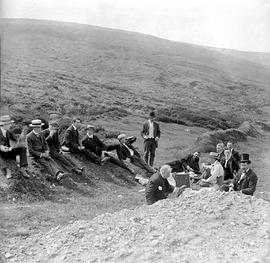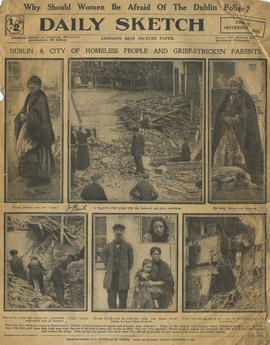Temperance Fliers, Pastoral Letters and Mission Cards
- IE CA MR/1/5/1
- File
- c.1900-1954
Part of Irish Capuchin Archives
The file includes various fliers, pastoral letters, mission cards and ephemera relating primarily to various temperance associations, and missions and retreats including the Father Mathew Temperance Sodality and the Young Irish Crusaders attached to the Capuchin Friary, Church Street, Dublin. The file includes:
• Pastoral letters on temperance composed by various Irish Bishops in 1900 including Patrick Joseph O’Donnell, Bishop of Raphoe, Robert Browne, Bishop of Cloyne, Richard Alphonsus Sheehan, Bishop of Waterford and Lismore, and John Keys O’Doherty, Bishop of Derry.
• Souvenir of the National Temperance Crusade preached by the Franciscan Capuchin Fathers (c.1906).
• Midwinter greeting to the Priests’ Total Abstinence League of America (31 Jan. 1908).
• Flier for Grand Abstinence Demonstration, Armagh (27 June 1909).
• Flier for St. Michael’s Temperance Society, Lower Cecil Street, Limerick (1909).
• Circular from the Most Rev. Thomas O’Dea (1858-1923), Bishop of Galway, to the clergy of the diocese re the Capuchin Temperance Mission. 8 Aug. 1909.
• Indulgences granted to temperance sodalities established by the Franciscan Capuchin Fathers.
• Souvenir of retreat for the Children of Mary attached to the Convent of St. Camillus, St. Patrick’s Kilkenny (8 Dec. 1915).
• The Catholic Bishops on Intemperance.
• Souvenir of the Temperance Crusade held at Kilmacow, County Kilkenny / 6th to 13th July 1913.
• Father Mathew Temperance Association in honour of the Sacred Thirst / Object, Means and Constitution of the Association (Nov. 1913).
• Souvenir of the General Mission for Men and Women held in St. Mary of the Angels, Church Street, Dublin (25 Jan. 1914).
• Enrolment card for the National Catholic Total Abstinence Congress, Dublin (June 1914). The card also gives details of the proceedings of the congress which closed with an address by Fr. Aloysius Travers OSFC, Provincial Minister.
• Ceremonial and instructions for Capuchin Fathers conducting Missions and Retreats. (24 Jan. 1912).
• Flier for Devotions at St. Augustine’s Church Galway on the Feast of Our Lady of Good Counsel (26 April 1915).
• Annual retreat of the Sisters of the Third Order of St. Francis (6 Oct. 1918).
• A week-long mission at the Church of Our Immaculate Lady of Refuge, Rathmines, Dublin.
• Temperance Rallying Songs published The Father Mathew Record Office, Church Street, Dublin. Words by Brian O’Higgins and music by Arthur Darley.
• Rules of St. Patrick Total Abstinence Society, Dundalk (May 1909).
• The Amethyst / a temperance lecture by Fr. Matthew Russell SJ. A manuscript note on the final page reads: ‘Recited in the Father Mathew OSFC Centenary Memorial Hall, Church Street, May 21st, 1894 by the Rev. Author before it was printed. Fr. Columbus Maher’.
• The Anti-Saloon League and its work / what position should our Catholic Total Abstinence Societies assume towards it? Speech given by John. T. Shea. Published by the CTU of America, Massachusetts. Aug. 1908.
• Flier for a Lenten mission given by Capuchin Fathers from Cork at the Corpus Christi Votive Basilica, (Corpus Christi Priory), Manchester. Feb. 1921.
• The Father Mathew Man, no. 19 (Nov. 1924). Published in Chicago.
• A Solemn Novena in honour of Our Lady of Mount Carmel in the Church of Saint Simon Stock / 182nd Street, Bronx, New York / Saturday, July 10th to Sunday, July 18th 1926. The sermons were given by Fr. Thomas Dowling OFM Cap.
• A remembrance of the mission preached by the Capuchin Fathers in the Pro-Cathedral, Dublin. 2-30 Mar. 1941.
• Young Irish Crusaders Prayer Book (St. Mary of the Angels, Church Street, Dublin, 1954).


